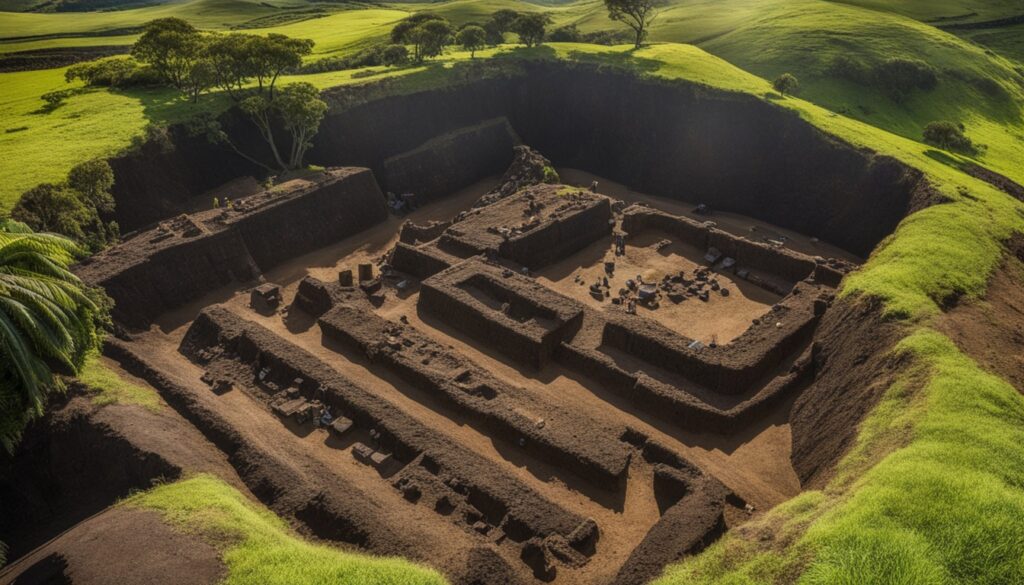The iconic Easter Island statues, known as moai, have long captivated the world with their enigmatic expressions and towering presence. However, recent excavations have revealed a surprising discovery: these monoliths have hidden bodies buried beneath the earth. Archaeologists have uncovered the buried torsos associated with the renowned heads, shedding new light on the fascinating civilization that once thrived on Easter Island.
The moai were carved by the indigenous Rapa Nui people between 1,100 and 1,500 CE, using stone found on the island. Over centuries, the statues were gradually buried by sediment and rocks, concealing their bodies while preserving them. The UCLA Easter Island Statue Project has been dedicated to studying and preserving these incredible artifacts, and their excavations have revealed the long-hidden torsos and bodies of several moai.
Key Takeaways
- The Easter Island statues, or moai, have hidden bodies buried underground.
- Archaeologists have uncovered the buried torsos, providing new insights into the Rapa Nui civilization.
- The moai were carved between 1,100 and 1,500 CE using local stone.
- Time and natural processes buried the statues, preserving their bodies.
- The UCLA Easter Island Statue Project has been studying and excavating the moai to reveal their hidden features.
The Mysterious Moai of Easter Island
The remote island of Easter Island, also known as Rapa Nui, is a volcanic island situated in the Polynesian Triangle of Oceania. This isolated island is renowned for its enigmatic collection of nearly 1,000 giant stone statues called moai, which have captivated the imagination of people worldwide.
The moai were created by the indigenous Rapa Nui people, believed to be of Polynesian descent, between A.D. 1100 and 1500. These impressive ancestral figures were carved from volcanic rock, with some standing up to 10 meters tall and weighing as much as 80 tons. The craftsmanship and scale of these sculptures are a testament to the skill and dedication of the ancient Polynesian peoples who inhabited the island.
Archaeologists and historians believe that the moai were created to honor and represent important tribal figures, such as chiefs or other prominent individuals, who had passed away. It is thought that each time a significant person died, a new statue was commissioned and erected in their memory.
The remote island setting and the sheer size and number of these ancestral figures have contributed to the enduring mystery surrounding the moai. The logistics of creating and transporting these giant sculptures using primitive tools and techniques continue to baffle researchers and capture the public’s imagination.
Despite the many theories and studies conducted, the exact purpose and meaning behind the moai remain shrouded in mystery. The enigmatic nature of these ancient statues has solidified Easter Island’s place as one of the most intriguing archaeological sites in the world, drawing visitors from far and wide to witness the awe-inspiring legacy of the Polynesian peoples who once called this remote island home.
Excavations Reveal Easter Island Statues’ Hidden Bodies
Recent excavations conducted by the Easter Island Statue Project, a team of archaeologists from UCLA, have uncovered the hidden bodies of the iconic Easter Island statues. The excavations focused on two of the moai heads, revealing their torso and truncated waist that had been buried beneath successive mass transport deposits on the island over time.
The monolithic moai statues were carved from the volcanic flows and tuffs of the Rano Raraku volcanic cone, which provided the stone material for these magnificent creations. As the archaeologists carefully excavated the buried statues, they made an intriguing discovery – etched petroglyphs on the backs of the figures. These petroglyphs commonly depicted crescent-shaped designs, believed to represent Polynesian canoes and likely serving as symbols of the carver’s family.

The excavations also shed light on the cultural practices of the Rapa Nui people. Abundant red pigment was found at human burial sites surrounding the statues, suggesting that the moai were painted red during ceremonies and that the Rapa Nui buried their dead in close proximity to their family’s statue. This discovery highlights the deep spiritual connection between the statues and the ancestral beliefs of the island’s inhabitants.
The Easter Island Statue Project’s groundbreaking excavations have not only revealed the hidden bodies of the moai but have also provided valuable insights into the artistry, symbolism, and cultural practices associated with these enigmatic statues. As more excavations continue, archaeologists hope to uncover further secrets and deepen our understanding of the fascinating history behind the iconic moai of Easter Island.
The Significance and Creation of the Moai
The moai statues of Easter Island were more than just representations of ancestors or chiefs. The very act of their creation and upright placement held great significance for the Rapa Nui people. Researchers have determined that the islanders employed ingenious carving techniques and engineering to erect these massive stone figures.
To raise the statues upright, the Rapa Nui dug deep holes next to the prone figures. They then inserted large tree trunks into these holes to act as levers. Using a system of ropes tied to the trunks, the islanders were able to hoist the statues into a standing position through a great coordinated effort. Remarkably, the Rapa Nui sculptors carved the heads and fronts of the statues while they were lying face-up on the ground. Only after leveraging them upright did they complete the carvings on the backs of the figures.
The tallest of the erected moai is a statue known as Paro, which stands an impressive 33 feet high. Hundreds of other statues were successfully raised in this manner throughout the island. However, by 1774 when Captain James Cook arrived, many had been toppled by the islanders themselves for unknown reasons. Those left standing were in a state of neglect. Cook expressed amazement at how the Rapa Nui, without any mechanical power, were able to raise such colossal statues. The moai remain as a testament to the ingenuity, skill and determination of this ancient Polynesian society.

Leave a Reply